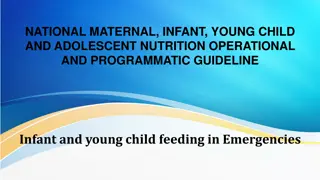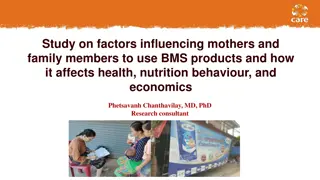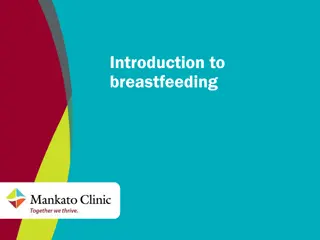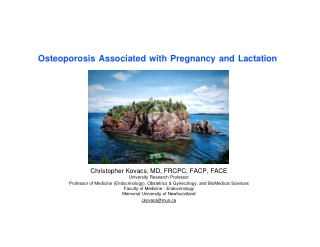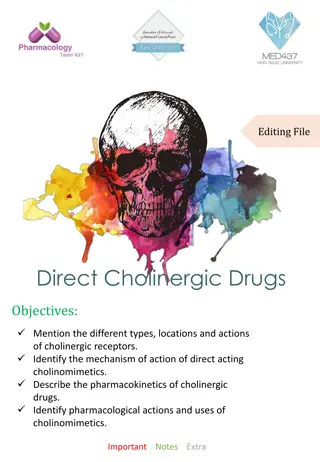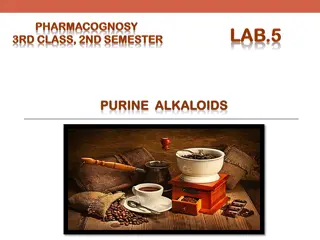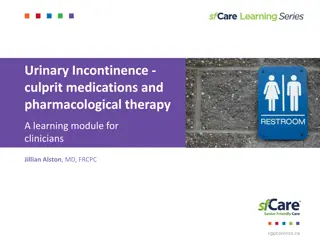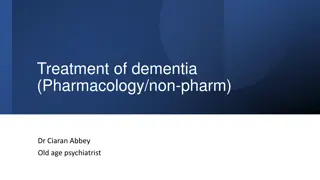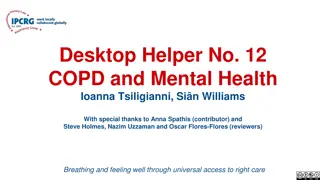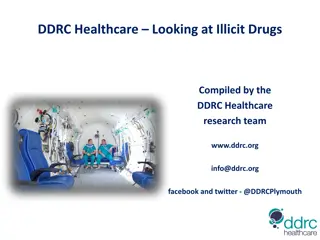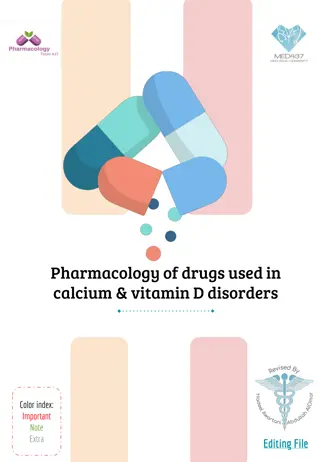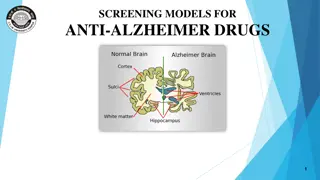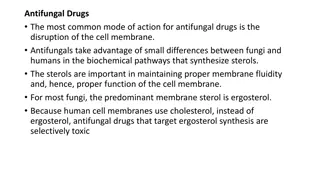Understanding Drugs and Lactation: Pharmacological Considerations in Breastfeeding
Learn about the impact of various medications on breast milk and lactation, including identifying adverse effects on babies, safe medication choices for breastfeeding women with specific conditions, drugs affecting lactation, and pharmacokinetic changes in pediatric populations.
Download Presentation

Please find below an Image/Link to download the presentation.
The content on the website is provided AS IS for your information and personal use only. It may not be sold, licensed, or shared on other websites without obtaining consent from the author. Download presentation by click this link. If you encounter any issues during the download, it is possible that the publisher has removed the file from their server.
E N D
Presentation Transcript
Drugs affecting breast milk and lactation Prof. Hanan Hagar Pharmacology Unit College of Medicine
Learning issues Student should be able to : Recognize the main pharmacological characters that control the passage of drugs from milk to baby. Identify the adverse effects of major pharmacological categories on babies. Describe the best and safest medication to be given to breast feeding women if she is suffered from different diseases as epilepsy, infection, diabetes, heart failure, hypertension. Know drugs that can inhibit lactation and should be avoided in breast feeding Know drugs that may enhance lactation.
LACTATION Breast feeding is very important because breast milk is the healthiest form of milk for babies. It provides the baby with immunoglobulins (IgA, IgM) that are essential for protection against gastroenteritis.
DRUGS AND LACTATION Most drugs administered to breast feeding woman are detectable in milk. The concentration of drugs achieved in breast milk is usually low (< 1 %). However, even small amounts of some drugs may be of significance for the suckling child. There are many pharmacokinetic and pharmacodynamics changes in pediatrics.
Pediatric population are classified into: Newborn: less than one month old Preterm neonates: born before 38 weeks of pregnancy Full-term neonates: 38-42 weeks of gestational age Infants (babies): 1 month 12 months of age Children: 1 -12 years of age Toddler (young child): 1-5 years Older child: 6-12 years Adolescent: 13-18 years
Pharmacokinetics changes in pediatrics Higher gastric pH Higher concentrations of free drug Higher percentage of body water Lower rate of metabolism due to immaturity of liver enzymes. Renal clearance is less efficient: ( Renal blood flow- GFR). Premature babies have very limited capacity for metabolism and excretion.
Physiologic Differences between Neonates and Adults of Pharmacokinetic Importance (Hilligoss 1980) Neonate Adult 0.15 Gastric acid output (mEq/10kg/hr) 2 65 87 Gastric emptying time (min) Total body water (% of body weight) 60 78 12 12-25 Adipose tissue (% of b.wt.) 3.7 4.5 Serum albumin (gm/dL) 70 11 Glomerular filtration rate (ml/min/m2)
Factors controlling passage of drugs into breast milk Factors related to drugs : Molecular weight Lipid solubility Degree of ionization Drug pH Protein binding Half life Oral bioavailability
Maternal factors: Dose of drug Route of administration Time of breast feeding Health status Maternal drug concentration
Factors controlling passage of drugs into breast milk Infants factors: Age Body weight Health status
Factors related to drugs Molecular weight: Very small molecules (< 200 Daltons) such as alcohol, equilibrate rapidly between plasma and breast milk via the aqueous channels surrounding alveoli. Large molecules drugs (>800 Daltons) are less likely to be transferred to breast milk than low molecular weight. Insulin: MW > 6,000 daltons Heparin: MW 40,000 daltons
Monoclonal antibodies, pass very poorly into milk after the first 1st week postpartum. The epithelium of the breast alveolar cells is most permeable to drugs during the 1st week postpartum, so drug transfer to milk may be greater during the 1st week of an infants life.
Lipid solubility of the drug: Lipid soluble drugs pass more freely into the breast milk than water soluble drugs. Degree of ionization: Ionized form of drugs are less likely to be transferred into breast milk. e.g., heparins pass poorly into breast milk
pH of drug: pH of milk is slightly more acidic than maternal blood. Weak basic drugs tend to concentrate in breast milk and become trapped secondary to ionization. Weak acidic drugs don't enter the milk to a significant extent and tend to be concentrated in plasma.
Effect of pH of the plasma and milk Maternal blood circulation Milk Milk pH is 7.2 More acidic plasma pH is 7.4 Ionized alkaline drug will be captured Alkalinedrug Nonionized acidic drug will diffuse back Acidic drug
Plasma protein binding of drugs Drugs circulate in maternal circulation in unbound (free) or bound forms to albumin. Only unbound form gets into maternal milk. Definition of good protein binding > 90% e.g. warfarin Half life of drug Avoid the use of drugs with long half lives short half life (t ) are preferable. Oxazepam vs diazepam
Volume of distribution Transfer of drug from maternal blood to milk is low with drugs that have large volume of distribution (Vd).
Factors related to mother Dose of the drug Route of administration Time of breast feeding Health status Maternal drug concentration
Factors related to mother Route of administration Route of administration affect the concentration of the drug in maternal blood. Maternal use of topical preparations (creams, nasal sprays or inhalers) are expected to carry less risk to a breastfed infant than systemically administered drugs.
Factors related to mother Time of breastfeeding The concentration of the drug in the milk at the time of feeding. Lactating mother should take medication just after nursing and 3-4 hours before the next feeding. (to allow time for drug to be cleared from the mother s blood drug concentration in milk will be low).
Health status Breastfeeding is contraindicated in case of: Mother HIV Active, untreated TB in mother Herpes on breast Use of illegal drugs by mother Certain medications
Factors related to neonates Age Body weight Health status
The amount of a drug to which the baby is exposed as a result of breast feeding depends on: The amount of milk consumed. The amount of drug absorbed from GI. The ability of the baby to eliminate the drug.
Age & Health status Special cautions are required in - Premature infants - Low birth weight - Infants with G6PD deficiency - Infants with impaired ability to metabolize /excrete drugs e.g. hyperbilirubinemia.
Neonatal hyperbilirubinemia Premature infants or infants with inherited G6PD deficiency are susceptible to oxidizing drugs that can cause hemolysis of RBCS bilirubin (hyperbilirubinemia) Kernicterus . Examples for oxidizing drugs: Antibiotics sulfonamides, trimethoprim Antimalarials: Primaquine
Neonatal Methemoglobinemia Infants under 6 months of age are particularly prone to develop methemoglobinemia upon exposure to some oxidizing drugs. Methemoglobin is an oxidized form of hemoglobin that has a decreased affinity for oxygen tissue hypoxia.
Drugs contraindicated during lactation Only few drugs are totally contraindicated Anticancer drugs Doxorubicin, cyclophosphamide, methotrexate Radiopharmaceuticals e.g. radioactive iodine CNS acting drugs amphetamine, heroin, cocaine Lithium Chloramphenicol Atenolol Potassium iodide
Drugs that can suppress lactation These drugs reduce prolactin Levodopa (dopamine precursor) Bromocriptine (dopamine agonist). Estrogen, combined oral contraceptives that contain high-dose of estrogen and a progestin. Androgens Thiazide diuretics
Drugs that can augment lactation Dopamine antagonists : they stimulate prolactin secretion galactorrhea e.g. Metoclopramide (antiemetic) Domperidone (antiemetic) Haloperidol (antipsychotic) Methyl dopa (antihypertensive drug) Theophylline (used in asthma)
Antibiotics No significant adverse effect Penicillins Ampicillin amoxacillin allergic reactions, diarrhea Cephalosporins No significant adverse effect Alterations to infant bowel flora Macrolides erythromycin clarithromycin hyperbilirubinemia -neonatal jaundice Should be avoided in premature infants or infants with G6PD deficiency Sulfonamides (co-trimoxazole)
Antibiotics Quinolones Theoretical risk of arthropathies Should be avoided Gray baby syndrome Chloramphenicol avoid Absorption by the baby is probably prevented by chelation with milk calcium. Avoid due to possible risk of teeth discoloration. hyperbilirubinemia -neonatal jaundice Should be avoided in premature infants or infants with G6PD deficiency Tetracyclines Sulfonamides (co-trimoxazole)
Sedative/hypnotics Barbiturates (phenobarbitone) Lethargy, sedation, poor suck reflexes with prolonged use. Benzodiazepines Single use of low doses is probably safe. Diazepam Lethargy, sedation in infants with prolonged use. Lorazepam
Antidiabetics Insulin Oral antidiabetics Metformin safe compatible avoid due to lactic acidosis
Analgesics Paracetamol safe Ibuoprofen compatible Aspirin avoid due to theoretical risk of Reye's syndrome
Oral contraceptives Non hormonal method should be used Avoid estrogens containing pills Estrogens milk quantity Progestin only pills or minipills are preferred for birth control.
Antithyroid drugs Propylthiouracil Carbimazole Methimazole potassium iodide May suppress thyroid function in infants. Propylthiouracil should be used rather than carbimazole or methimazole. Anticoagulants Heparin Safe, not present in breast milk. Warfarin can be used, very small quantities found in breast milk, monitor the infant's prothrombin time during treatment. Warfarin
Preferable over others Anticonvulsants Compatible with breastfeeding Carbamazepine Amounts entering breast milk are not sufficient to produce adverse effects Phenytoin Valproic acid Infants must be monitored for CNS depression avoid Lamotrigine Antidepressants SSRI Paroxetine is the preferred SSRI in breastfeeding women.
Cytotoxic drugs Breast feeding should be avoided Iodine (radioactive) Permanent hypothyroidism in infant Breast-feeding is contraindicated Lithium Large amounts can be detected in milk avoid CVS drugs Atenolol Risk of bradycardia and hypoglycemia avoid
Drugs of choice in lactation Antibiotics Cephalosporins, penicillins are safe Avoid: chloramphenicol, quinolones, sulphonamides and tetracyclines Insulin oral antidiabetics are safe Avoid: metformin Heparin warfarin Acetaminophen (paracetamol) Propylthiouracil is preferable over others Antidiabetics Anticoagulants Analgesics Antithyroid drugs Anticonvulsants Oral contraceptives Carbamazepine - phenytoin Progestin only pills or minipills are preferredfor birth control. Inhaled corticosteroids - prednisone Antiasthmatics
Summary for choice of drug Route of administration (topical, local, inhalation) instead of an oral form. Short acting Highly protein bound Low lipid solubility High molecular weight Poor oral bioavailability No active metabolites well-studied in infants
General considerations Infants should be monitored for adverse effects e.g. feeding, sedation, irritability, rash, etc. Drugs with no safety data should be avoided or lactation should be discontinued
General considerations Do not guess Use the following sources: Use Medication and Mothers Milk (www.iBreastfeeding.com) Use lactmed or toxnet (http://toxnet.nlm.nih.gov ) a free online database with information on drugs and lactation, is one of the newest additions to the National Library of Medicine's TOXNET system, a Web-based collection of resources covering toxicology, chemical safety, and environmental health.
Thank you Questions ?





